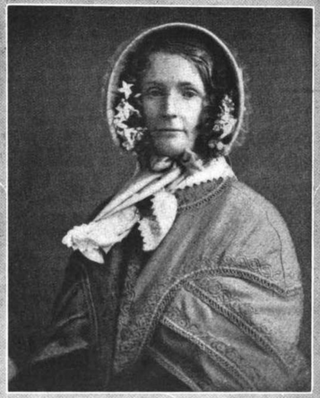
Shopping is an activity in which a customer browses the available goods or services presented by one or more retailers with the potential intent to purchase a suitable selection of them. A typology of shopper types has been developed by scholars which identifies one group of shoppers as recreational shoppers, that is, those who enjoy shopping and view it as a leisure activity.

Maria Weston Chapman was an American abolitionist. She was elected to the executive committee of the American Anti-Slavery Society in 1839 and from 1839 until 1842, she served as editor of the anti-slavery journal The Non-Resistant.

A donation is a gift for charity, humanitarian aid, or to benefit a cause. A donation may take various forms, including money, alms, services, or goods such as clothing, toys, food, or vehicles. A donation may satisfy medical needs such as blood or organs for transplant.

A flea market is a type of street market that provides space for vendors to sell previously owned (second-hand) goods. This type of market is often seasonal. However, in recent years there has been the development of 'formal' and 'casual' markets which divides a fixed-style market (formal) with long-term leases and a seasonal-style market with short-term leases. Consistently, there tends to be an emphasis on sustainable consumption whereby items such as used goods, collectibles, antiques and vintage clothing can be purchased, in an effort to combat climate change and fast fashion.

A bazaar or souk is a marketplace consisting of multiple small stalls or shops, especially in the Middle East, the Balkans, North Africa and South Asia. However, temporary open markets elsewhere, such as in the West, might also designate themselves as bazaars. The ones in the Middle East were traditionally located in vaulted or covered streets that had doors on each end and served as a city's central marketplace. Street markets are the European and North American equivalents.
The Queen Margaret Union (QMU) is one of two students' unions at the University of Glasgow, Scotland. Founded in 1890, it caters to the social and cultural needs of its members by providing a range of services including volunteering opportunities, entertainment, catering, bars and games.

Fundraising or fund-raising is the process of seeking and gathering voluntary financial contributions by engaging individuals, businesses, charitable foundations, or governmental agencies. Although fundraising typically refers to efforts to gather money for non-profit organizations, it is sometimes used to refer to the identification and solicitation of investors or other sources of capital for for-profit enterprises.

Many have seen the status of women in the Victorian era as an illustration of the striking discrepancy between the United Kingdom's national power and wealth and what many, then and now, consider its appalling social conditions. During this era, whose sobriquet refers to the reign of a female monarch, Queen Victoria, women did not have the right to vote, sue, or if married, own property. At the same time, women labored within the paid workforce in increasing numbers following the Industrial Revolution. Feminist ideas spread among the educated middle classes, discriminatory laws were repealed, and the women's suffrage movement gained momentum in the last years of the Victorian era.

Vivian Chow Wai-man is a Hong Kong-based Cantopop singer-songwriter and actress.

A jumble sale (UK), bring and buy sale or rummage sale is an event at which second hand goods are sold, usually by an institution such as a local Boys' Brigade Company, Scout group, Girlguiding group or church, as a fundraising or charitable effort. A rummage sale by a church is called a church sale or white elephant sale, frequently as part of a church bazaar.
Consignment is a process whereby a person gives permission to another party to take care of their property and retains full ownership of the property until the item is sold to the final buyer. It is generally done during auctions, shipping, goods transfer, or putting something up for sale in a consignment store. The owner of the goods pays the third-party a portion of the sale for facilitating the sale. Consignors maintain the rights to their property until the item is sold or abandoned. Many consignment shops and online consignment platforms have a set time limit at which an item's availability for sale expires. Within the time of contract, reductions of the price are common to promote the sale of the item, but vary by the type of item sold.

Deseret Industries is a non-profit organization and a division of the welfare services provided by the Church of Jesus Christ of Latter-day Saints.

A tianguis is an open-air market or bazaar that is traditionally held on certain market days in a town or city neighborhood in Mexico and Central America. This bazaar tradition has its roots well into the pre-Hispanic period and continues in many cases essentially unchanged into the present day. The word tianguis comes from tiyānquiztli or tianquiztli in Classical Nahuatl, the language of the Aztec Empire. In rural areas, many traditional types of merchandise are still sold, such as agriculture supplies and products as well as modern, mass-produced goods. In the cities, mass-produced goods are mostly sold, but the organization of tianguis events is mostly the same. There are also specialty tianguis events for holidays such as Christmas as well as for particular types of items such as cars or art.
Sobell House Hospice is an Oxford-based hospice serving the residents of Oxfordshire, England affected by life-limiting illness.

Stourbridge fair was an annual fair held on Stourbridge Common in Cambridge, England. At its peak it was the largest fair in Europe and was the inspiration for Bunyan's "Vanity Fair".
Sacred Heart Mission in St Kilda, an inner suburb of Melbourne, is a medium-sized not-for-profit organisation that grew from the Catholic parish of The Sacred Heart in Grey Street, West St Kilda. It addresses homelessness, social exclusion and disadvantage by providing a range of diverse and creative services that:
Bazaar Stars Charity Night is an annual fundraising gala hosted by Harper’s Bazaar China in China for Chinese celebrities who support charities. The event was founded at 2003 due to the outbreak of SARS upon Na Ying's suggestion and the fundraising event was continued every year ever since. Since 2014, the charity night has been a collaboration between Harper's Bazaar China and Zhejiang Television where the latter will broadcast the charity night on national television. In recent years, the event is divided into the auction segment and the donation segment with intervals of performances.
The retail format influences the consumer's store choice and addresses the consumer's expectations. At its most basic level, a retail format is a simple marketplace, that is; a location where goods and services are exchanged. In some parts of the world, the retail sector is still dominated by small family-run stores, but large retail chains are increasingly dominating the sector, because they can exert considerable buying power and pass on the savings in the form of lower prices. Many of these large retail chains also produce their own private labels which compete alongside manufacturer brands. Considerable consolidation of retail stores has changed the retail landscape, transferring power away from wholesalers and into the hands of the large retail chains.
Anti-slavery fairs were meetings in the 1830s through 1860s where American abolitionists, particularly women, sold goods and distributed and discussed anti-slavery ideas.

Choose Love is a UK-based non-governmental organization (NGO) which provides humanitarian aid to, and advocacy for, refugees around the world. In 2016, it became the largest grassroots distributor of aid in Europe.
















